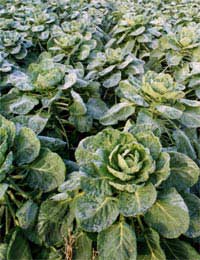
Plan and efficiently store your year’s crop using our month-by-month notes. You might want to print this page and keep it stuck to the fridge…
January to March: PLANTING
There isn’t much to plant in January, particularly if you get a cold snap and the ground freezes over. By March, the list starts to lengthen as you approach the vegetable gardener’s busiest time of year! When sowing the slow-growing crops, you might wish to interplant with quick crops such as lettuce and radish (which will be cleared ages before the main crops need the space). Here’s an overview of jobs for this season.
January:
- Sweet Peas (for cutting) – sow in trays and keep in a cold frame or porch.
- Round Peas – overwintering varieties can be sown between January and March.
- Broad Beans – overwintering varieties; stagger sowings, making one winter and one spring bed.
February:
- Jerusalem Artichokes – tubers can go in this month – careful where you put them, as they can grow up to 10′ tall!
- Leek – sow indoors or in a cold frame.
- Spring onion – sow under a cloche or glass-covered nursery bed.
- Shallots – plant sets direct.
March:
- Broccoli – early autumn types. Protect from cabbage fly immediately.
- Brussels Sprouts – sow direct.
- Cabbage – transplant autumn-sown varieties to their beds.
- Cauliflower – transplant autumn-sown varieties.
- Parsnip – sow direct.
- Early potatoes – plant after St Patrick’s Day!
- Radish – sow just a few at a time, to avoid a glut. Make sowings at two-week intervals until September.
- Spinach (hardy types) – sow direct.
- Tomato – sow indoors or in a heated greenhouse.
- Turnip – sow outdoors, direct
January to March: STORING AND FREEZING
If you’ve planned your vegetable patch carefully, you will still have things to harvest in January. March is the notorious ‘hungry gap’; however, good stores of roots, leeks and winter greens should see you through it.
Leeks – if it’s very frosty or you want them closer to home, ‘heel in’ the leeks in a shallow trench close to the house.
Parsnips – store in trays in the shed, packed in sand. Alternatively, peel, core and freeze parsnip halves ready to roast.
Jerusalem Artichokes – store in a cool, dark shed or peel and freeze the remainder for soups.
Beetroot – available from storage shed: continue to use supplies. If they get woody, pickle some in good vinegar.
Brussels Sprouts – pick as needed; if plants deteriorate and you have to harvest them all, blanch sprouts before freezing.
Celeriac – keeps for ages in a cool place; take a knife and harvest (trimming root) as needed. If hard frosts persist, cover bed with straw.
Winter Radish – harvest as needed, taking whole row if they get too big (staggered sowing should avoid this problem).
Swiss Chard – continue picking leaves from the outside in. Chop the leaves, blanch them and wring out moisture before freezing: the winter leaves are a bit tougher, so require longer cooking.
Seville Oranges – OK, you can’t grow these in the British climate, but the ‘marmalade orange’ becomes available from January. It’s the perfect time to spend a few hours in the kitchen making a big batch of marmalade to keep and give away.
